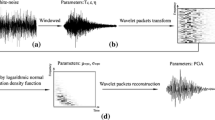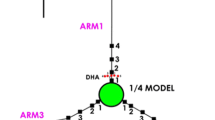Abstract
Spatial variability of strong ground motion within the dimensions of a horizontally extended structure is often described in terms of spectral parameters, such as autospectral densities and cross-spectral densities of motion, recorded at an array of closely spaced sensors. Traditionally, windowed and tapered periodogram techniques have been used in processing strong-motion array data, whereby spectral quantities are estimated. This approach involves large variances in the computed estimates, which can be reduced by decreasing the bandwidth of smoothing windows. A major problem in such applications is the selection of an optimal window, for which, as far as we know, no formal mathematical criteria exist. In this paper we propose a novel technique, based on parametric time series modelling, to replace the periodogram technique for estimating spectral quantities relevant to the description of spatial variability of ground motion. By using actual earthquake data recorded by a strong-motion array, we demonstrate that autoregressive (AR) time series modelling can be used in spectral analysis of strong-motion array data. Such models can easily be calibrated using a variant of least squares techniques, and well-defined statistical criteria are used to identify an optimal model to describe the recorded data. The application of AR modelling eliminates the subjective judgement involved in periodogram techniques and provides stabler estimates of lagged coherencies.
Similar content being viewed by others
References
Akaike H (1970) Statistical predictor identification. Ann Inst Stat Math 22(1): 203–217
Akaike H (1974) A new look at the statistical model identification. IEEE Trans Autom Control AC 19: 716–722
Beamish N, Priestley MB (1981) A study of autoregressive and window spectral estimation. J R Stat Soc Appl Stat 30(1): 41–58
Broersen PMT (2006) Automatic autocorrelation and spectral analysis. Springer, Verlag
Box GEP, Jenkins GM, Reinsel GC (2008) Time series analysis: forecasting and control, 4th edn. John Wiley Sons, Inc., New Jersey
Burg JP (1968) A new analysis technique for time series data. NATO Advanced Study Institute on Signal Processing, Enschede
Hao H, Oliveira CS, Penzien J (1989) Multiple station ground motion processing and simulation based on SMART1 array data. Nucl Eng Des 111: 293–310
Hindy A, Novak M (1980) Pipeline response to random ground motion. J Eng Mech Div ASCE 106(2): 339–360
Jenkins GM, Watts DG (1969) Spectral analysis and its applications. Holden Day, San Francisco, CA
Kay SM, Marple SL (1981) Spectrum analysis: a modern perspective. Proc IEEE 69: 1380–1419
Ljung L (1999) System identification: theory for the user, 2nd edn. Prentice Hall, Upper Saddle River, NJ
Loh CH, Penzien J, Tsai YB (1982) Engineering analysis of SMART1 array accelerograms. Earthq Eng Struct Dyn 10: 575–591
Newland DE (1993) An introduction to random vibrations, spectral and wavelet analysis, 3rd edn. Wiley, New York, NY
Newmark NM, Rosenblueth E (1971) Fundamentals of earthquake engineering. Prentice Hall, Inc., Englewood Cliffs, NJ
Oliveira CS, Hao H, Penzien J (1991) Ground motion modeling for multiple input structural analysis. Struct Saf 10: 79–93
Parzen E (1974) Some recent advances in time series modelling. IEEE Trans Autom Control AC 19(6): 723–730
Pavageau M, Rey C, Elicer-Cortes J-C (2004) Potential benefit from the application of autoregressive spectral estimators in the analysis of homogeneous and isotropic turbulence. Exp Fluids 36: 847–859
Penzien J, Watabe M (1975) Characteristics of 3 dimensional earthquake ground motions. Earthq Eng Struct Dyn 3: 365–373
Vanmarcke E (1983) Random fields: analysis and synthesis. MIT Press, Cambridge, MA
Walker G (1931) On periodicity in series of related terms. Proc R Soc Lond A 131: 518–532
Yule GU (1927) On a method of investigating periodicities in disturbed series, with special reference to Wolfer’s sunspot numbers. Philos Trans R Soc Lond A 226: 267–298
Zerva A (1986) Stochastic differential ground motion and structural response. Ph.D. thesis, Department of Civil Engineering, University of Illinois at Urbana Champaign, Urbana, IL
Zerva A (2009) Spatial variation of seismic ground motions, modelling and engineering applications. CRC Press, Taylor and Francis Group, LLC, Boca Raton, FL
Zerva A, Zervas V (2002) Spatial variation of seismic ground motions: an overview. Appl Mech Rev ASME 55: 271–297
Author information
Authors and Affiliations
Corresponding author
Rights and permissions
About this article
Cite this article
Rupakhety, R., Sigbjörnsson, R. Spatial variability of strong ground motion: novel system-based technique applying parametric time series modelling. Bull Earthquake Eng 10, 1193–1204 (2012). https://doi.org/10.1007/s10518-012-9352-0
Received:
Accepted:
Published:
Issue Date:
DOI: https://doi.org/10.1007/s10518-012-9352-0




